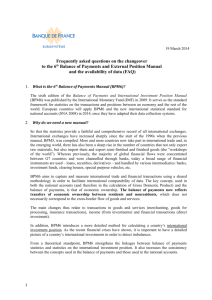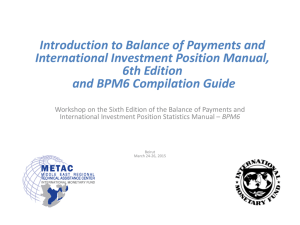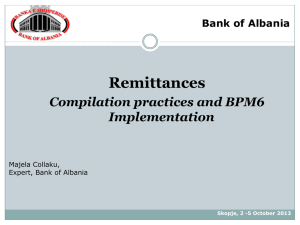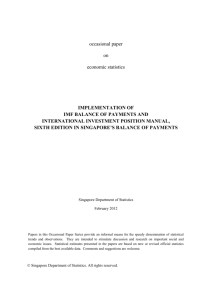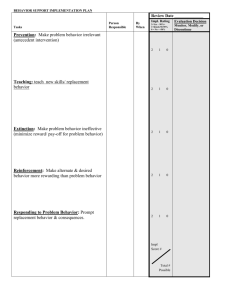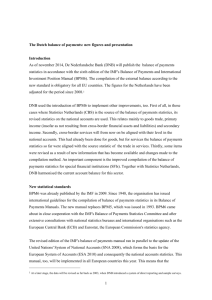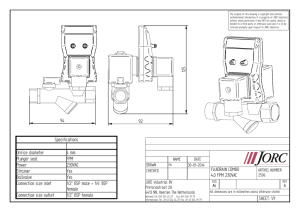BSP Implementation of BPM6
advertisement
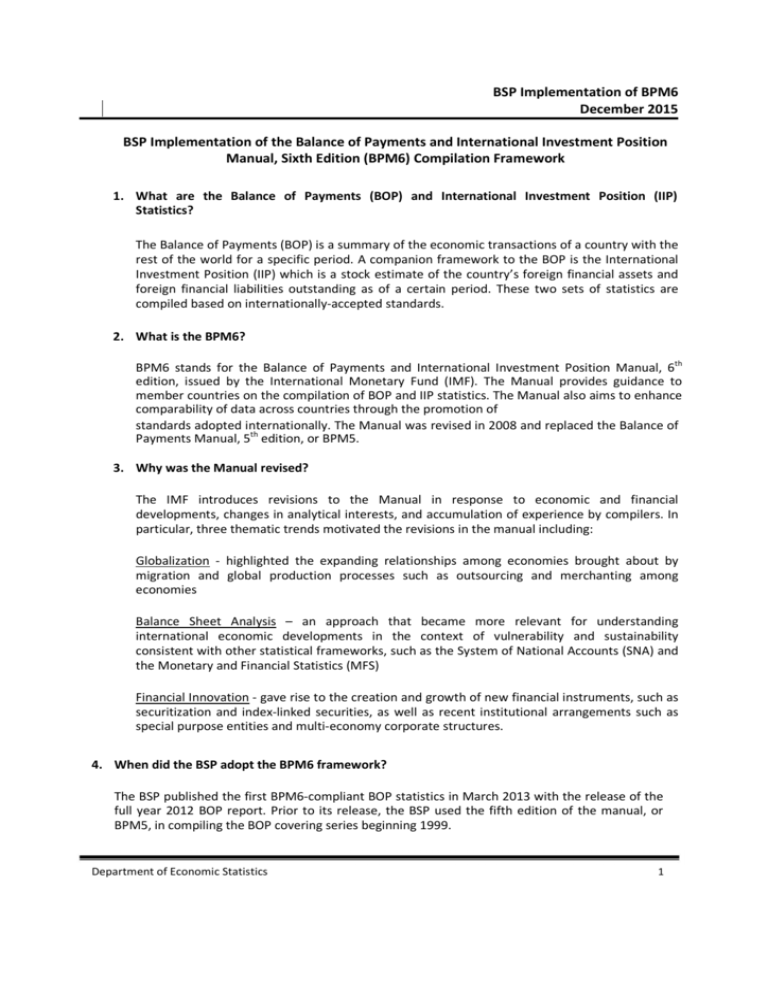
BSP Implementation of BPM6 December 2015 BSP Implementation of the Balance of Payments and International Investment Position Manual, Sixth Edition (BPM6) Compilation Framework 1. What are the Balance of Payments (BOP) and International Investment Position (IIP) Statistics? The Balance of Payments (BOP) is a summary of the economic transactions of a country with the rest of the world for a specific period. A companion framework to the BOP is the International Investment Position (IIP) which is a stock estimate of the country’s foreign financial assets and foreign financial liabilities outstanding as of a certain period. These two sets of statistics are compiled based on internationally-accepted standards. 2. What is the BPM6? BPM6 stands for the Balance of Payments and International Investment Position Manual, 6th edition, issued by the International Monetary Fund (IMF). The Manual provides guidance to member countries on the compilation of BOP and IIP statistics. The Manual also aims to enhance comparability of data across countries through the promotion of standards adopted internationally. The Manual was revised in 2008 and replaced the Balance of Payments Manual, 5th edition, or BPM5. 3. Why was the Manual revised? The IMF introduces revisions to the Manual in response to economic and financial developments, changes in analytical interests, and accumulation of experience by compilers. In particular, three thematic trends motivated the revisions in the manual including: Globalization - highlighted the expanding relationships among economies brought about by migration and global production processes such as outsourcing and merchanting among economies Balance Sheet Analysis – an approach that became more relevant for understanding international economic developments in the context of vulnerability and sustainability consistent with other statistical frameworks, such as the System of National Accounts (SNA) and the Monetary and Financial Statistics (MFS) Financial Innovation - gave rise to the creation and growth of new financial instruments, such as securitization and index-linked securities, as well as recent institutional arrangements such as special purpose entities and multi-economy corporate structures. 4. When did the BSP adopt the BPM6 framework? The BSP published the first BPM6-compliant BOP statistics in March 2013 with the release of the full year 2012 BOP report. Prior to its release, the BSP used the fifth edition of the manual, or BPM5, in compiling the BOP covering series beginning 1999. Department of Economic Statistics 1 BSP Implementation of BPM6 December 2015 Some data revisions, however, have already been effected prior to 2013 to comply with specific provisions in the BPM6 framework. In particular, the BSP has already adopted starting September 2010 the revised treatment of Special Drawing Rights (SDR) allocation in the BOP statistics and the refined measure of personal remittances in June 2012. The SDR is an international reserve asset created by the IMF in 1969 to supplement the existing official reserves of member countries. SDRs are allocated to member countries, in proportion to their IMF quotas, and were made available by the IMF to its members, including the Philippines. SDR allocations, under the BPM5 framework, are considered as non-transaction items and are not included in the BOP. SDRs, therefore, do not affect the country’s BOP position. Since SDR allocations are not considered liabilities, these do not impact the country’s external debt as well. Meanwhile, as SDRs increase the reserve assets of the country, they also raise the country’s IIP. Under BPM6, SDR allocations are treated as transactions, particularly as long-term liabilities of the monetary authority. The shift in treatment of SDRs has been reflected in various statistics generated and monitored by the BSP, including the BOP, IIP, External Debt Statistics (EDS), and MFS. In March 2014, the BSP fully implemented the shift of the BOP compilation to BPM6 framework in compliance with the recommendations set out in the BOP manual. Meanwhile, the compilation of IIP data based on BPM6 framework was completed in September 2014 with the simultaneous release of the quarterly IIP data as of end-March 2013 to end-June 2014. Backtracked IIP data series (annual 2006-2012) and (quarterly 2013) were also posted in the BSP website 5. What other changes were implemented with the shift to the BPM6 framework? As a framework, BPM6 has a high degree of continuity with BPM5. While the overall framework is the same, BPM6 incorporates more elaborations and clarifications that have been identified since the fifth edition was introduced. Moreover, the sixth edition provides for stronger theoretical foundations and linkages to other macroeconomic statistics. Aside from the revised treatment of SDR allocations, the following changes were implemented: a. Reclassifying the international accounts and underlying transactions by institutional sector to harmonize with the SNA b. In March 2014, the BSP fully implemented the shift of the BOP compilation to BPM6 framework in compliance with the recommendations set out in the BOP manual. Meanwhile, the compilation of IIP data based on BPM6 framework was completed last September 2014 with the simultaneous release of the quarterly IIP data as of end-March 2013 to end-June 2014, Following the implementation of the BPM6 compilation framework, the BSP released the backtracked BOP monthly data series from 2005-2010 (with accompanying technical notes) in the BSP website in March 2014. Apart from the conversion to BPM6 format, the revisions to the backtracked BOP data series mainly reflected the use of new data sources and estimation methodologies to generate more accurate and reliable BOP statistics. Meanwhile, backtracked IIP data series (annual 2006-2012) and (quarterly 2013) were posted in the BSP website in September 2014. Department of Economic Statistics 2 BSP Implementation of BPM6 December 2015 The Manual adopts a condensed version of the SNA institutional sector classification for the BOP standard components. BPM6 classifies the international accounts into four major institutional sectors: central bank, deposit-taking corporations except the central bank, general government, and other sectors. The classification of institutional sectors under BPM5 and BPM6 are presented in Table 1. Table 1. Classification of Institutional Sectors BPM5 BPM6 Monetary Authorities Central Bank Banks Deposit-taking corporations except the * central bank General Government General government Other Sectors Other sectors * Other financial corporations – including money market funds (MMF), non-MMF investment funds, other financial intermediaries except insurance corporations and pension funds, financial auxiliaries, captive institutions and money lenders, insurance corporations, pension funds Nonfinancial corporations, households, and NPISHs (nonprofit institutions serving households; may be * combined with households) Additional sectors for counterpart data: International organizations International financial organizations Central bank of currency union Other international organizations * Public corporations may be shown as “of which” items for the financial and nonfinancial corporations sectors or subsectors as supplementary items, when relevant. b. Revising statistical treatment, coverage, and presentation of some international accounts The Manual recommends a revised statistical treatment and coverage of some international accounts. Some account names have also been changed to harmonize with the SNA terminology. The revisions are presented on a by account component. Department of Economic Statistics 3 BSP Implementation of BPM6 December 2015 Current Account Revisions in the current account are presented below: Table 2. Comparison of Major BPM6 Revisions in the Current Account International BPM5 BPM6 Account Current Account Goods Goods for processing (such as goods Goods for processing and repair are imported or exported on excluded; these items are recorded consignment basis) and repair are under services. included in the goods category. Services Categories of trade in services include: transportation; travel; communication services; construction services; insurance services; financial; computer and information services; royalties and license fees; other business services; personal, cultural and recreational services; and government services not included elsewhere (n.i.e.). The services category also includes merchanting and other traderelated services. An expanded classification of services was introduced, with categories mainly product-based (i.e., classified according to the type of service), except for travel, construction, and government goods and services n.i.e., which are transactorbased (i.e., classified according to the unit that provides the service). Merchanting and other trade-related services are excluded; these items are recorded under goods. The Manual also renamed some accounts, e.g., manufacturing services on physical inputs owned by others (to replace goods for processing) and charges for the use of intellectual property n.i.e. (formerly royalties and license fees). Financial intermediation service charges indirectly measured (FISIM), pertaining to implicit margins between interest payable and the reference rate on loans and deposits, are now part of financial services. A new grouping of telecommunications, computer, and information services was also introduced in the Manual, to include a range of relevant services. Primary Income Account name used is Income. Account is classified into compensation of employees including border, seasonal, and other workers; and investment income. Department of Economic Statistics Account name was changed to Primary Income, to harmonize the BPM6 account with the SNA terminology. A sub-account, other primary income, was also introduced, consisting of rent, taxes and subsidies on products and 4 BSP Implementation of BPM6 December 2015 Table 2. Comparison of Major BPM6 Revisions in the Current Account International BPM5 Account Rent is included in other investment production. income, while taxes and subsidies are included in current transfers. Secondary Income Account name used is Current Transfers. Current categories include workers’ remittances and other transfers. BPM6 Account name was changed to Secondary Income, to harmonize the account with the SNA. The Manual introduces a broader term, personal transfers, of which workers’ remittances are a subset of. Briefly defined, personal transfers comprise all current transfers in cash or in kind sent or received by resident households to or from non-resident households. One of the highlighted revisions introduced in BPM6 is the refinement in the measure of remittances. The BPM6 identifies the standard components and provides supplementary items to allow compilation of remittance aggregates. The standard components of remittances refer to the compensation of employees (lodged under the Primary Income account) and personal transfers (lodged under the Secondary Income account). Each component is defined in BPM6 as follows: • • Compensation of employees – refers to the income of border, seasonal, and shortterm workers who work in an economy where they are not residents of; and Personal transfers – refer to all current transfers (in cash and in kind) between resident and non-resident individuals. Meanwhile, the supplementary components of remittances consist of personal remittances, total remittances, and total remittances and transfers to non-profit institutions serving households (NPISHs). The items under the supplementary components also represent the three categories of remittances from the viewpoint of the recipient economy (Table 3). Department of Economic Statistics 5 BSP Implementation of BPM6 December 2015 Table 3. BPM6 Definitions of Remittances Total remittances and transfers to NPISHs: a+b+c+d+e+f Total remittances: a+b+c+d Personal remittances: a+b+c a Personal transfers (part of current transfers) b Compensation of employees less taxes, social contributions, transport, and travel c Capital transfers between households d Social benefits e Current transfers to NPISHs f Capital transfers to NPISHs The supplementary items related to remittances are defined in BPM6 as follows: • • • Personal remittances - include all household-to-household transfers between residents and non-residents, and the net compensation of employees (i.e., gross earnings excluding taxes, social contributions, and transportation and travel expenditures payable by border, seasonal, and other short-term workers outside their economy of residence); Total remittances – include income from individuals working abroad for short periods, income from individuals residing abroad, and social benefits from abroad; and Total remittances and transfers to NPISHs - include all transfers benefiting households directly or indirectly through NPISHs, as well as the net earnings of short term workers abroad. Capital Account Revisions in the capital account are presented below: Table 4. Comparison of Major BPM6 Revisions in the Capital Account BPM5 BPM6 Capital Account Consists of capital transfers in the Migrants’ transfers are now excluded form of migrants’ transfers, debt from capital transfers in the BOP as the forgiveness, and other noncurrent change in residence does not involve a transfers, as well as transaction between two entities, but a acquisition/disposal of nonproduced, change in the status of a single entity. nonfinancial assets. These migrants’ transfers, however, are recorded as other flows/adjustment in the IIP. Patents and copyrights, which were previously treated as nonproduced assets in the capital account, are now classified as produced assets under specific services, e.g., research and development Department of Economic Statistics 6 BSP Implementation of BPM6 December 2015 Financial Account 1) Improved functional categories Functional categories refer to the primary classification used for the financial transactions, positions, and income in the international accounts. The categories under BPM5 and BPM6 are presented in Table 5. Table 5. Functional Categories BPM5 Direct investment Portfolio investment Financial derivatives Other investments Reserve assets BPM6 Direct investment Portfolio investment Financial derivatives (other than reserves) and employee stock options Employee stock options Other investments Reserve assets 2) Further classification of direct investments Under BPM6, direct investments are classified further according to the relationship between the investor and the recipient entity, as follows: a) Investment by a direct investor in its direct investment enterprise (DIE) – where an entity or group of related firms is able to exercise control or a significant degree of influence over a direct investment enterprise; b) Reverse investment – when a DIE lends funds to or acquires entity in its direct investor, provided it does not own equity of 10 percent or more of the voting power in that direct investor; and c) Investment between fellow enterprises – where enterprises are under the control or influence of the same immediate or indirect investor, but the fellow enterprises do not control or influence each other. 3) Expanded classification of financial assets and liabilities by instrument type The BPM6 adopts a broader classification of categories of financial assets and liabilities for purposes of harmonizing with the 2008 SNA (Table 6). The new set of categories represent a more structured classification of the three broader categories of financial assets and liabilities, namely, equity and investment fund shares, debt instruments, and other financial assets and liabilities. Department of Economic Statistics 7 BSP Implementation of BPM6 December 2015 Table 6. Classification of Financial Instruments: 2008 SNA and BPM6 2008 SNA BPM6 Monetary Gold Gold bullion Other financial assets and Unallocated gold accounts liabilities Special drawing rights Debt instruments Currency and deposits Debt instruments Currency Interbank positions Other transferable deposits Other deposits Debt securities Debt instruments Loans Debt instruments Equity and investment fund shares Equity Equity Listed shares Unlisted shares Other equity Investment fund shares/units Money market fund shares/units Other investment fund shares/units Insurance, pension and standardized guarantee schemes Debt instruments Nonlife insurance technical reserves Life insurance and annuity entitlements Pension entitlements Claims of pension funds Entitlements to nonpension benefits Provisions for calls under standardized guarantees Financial derivatives and employee stock options Other financial assets and Financial derivatives Liabilities Forward-type contracts Options Employee stock options Other accounts receivable/payable Debt instruments Trade credit and advances Other accounts receivable/payable 4) Revised accounting convention in the financial account Under the BPM5, the accounting entries terminology/conventions used in the international accounts are Debit and Credit. In the BPM6, the concept of “Net acquisition of financial assets (NAFA)” and “Net incurrence of liabilities (NIL)” in the case of transactions in financial assets and liabilities is introduced. In particular, under BPM6, the terms “credit” and “debit” are used in current and capital accounts, while the term NAFA and NIL are used in financial accounts. The use of the terms NAFA and NIL highlights the impact of the financial account on the International Investment Position (IIP). The use of these terms also simplifies the interpretation of data (Table 7). Department of Economic Statistics 8 BSP Implementation of BPM6 December 2015 Table 7. Accounting Convention BPM5 BPM6 Current Account Debit and credit Debit and credit Capital Account Debit and credit Debit and credit Financial Account Debit and credit NAFA and NIL Department of Economic Statistics 9
